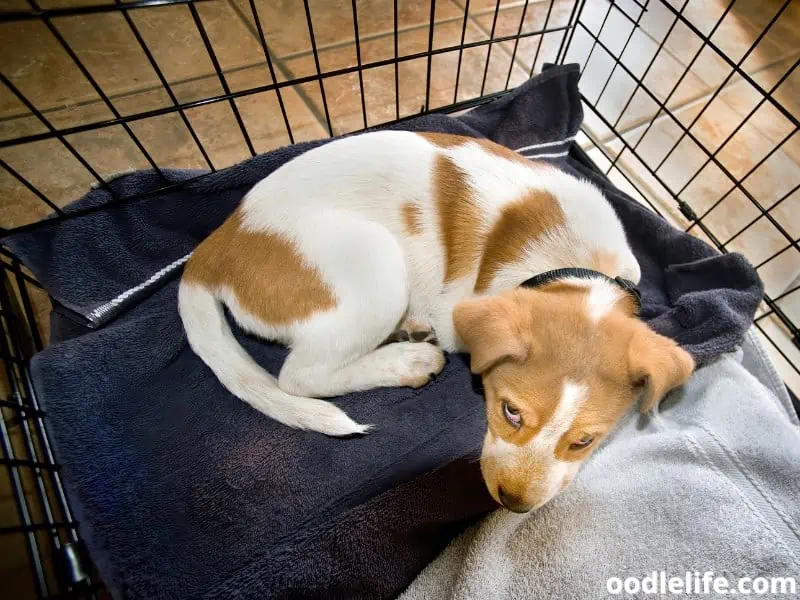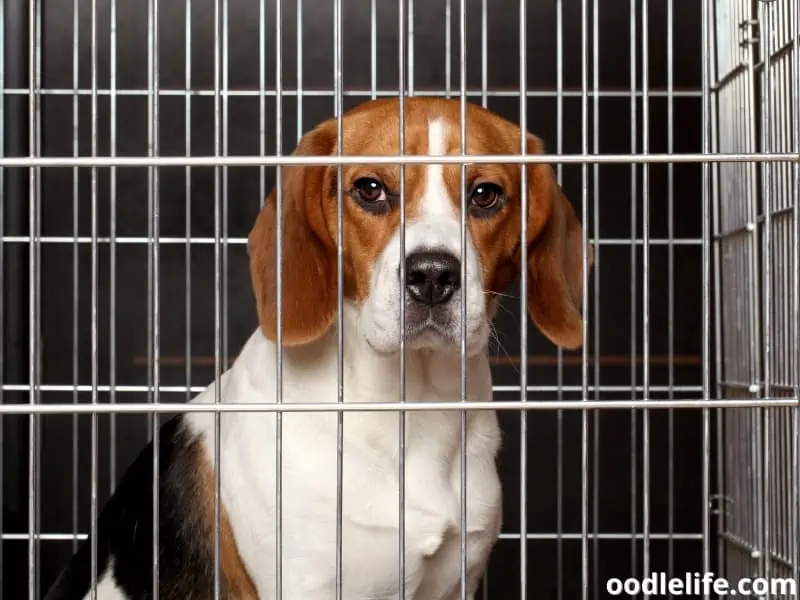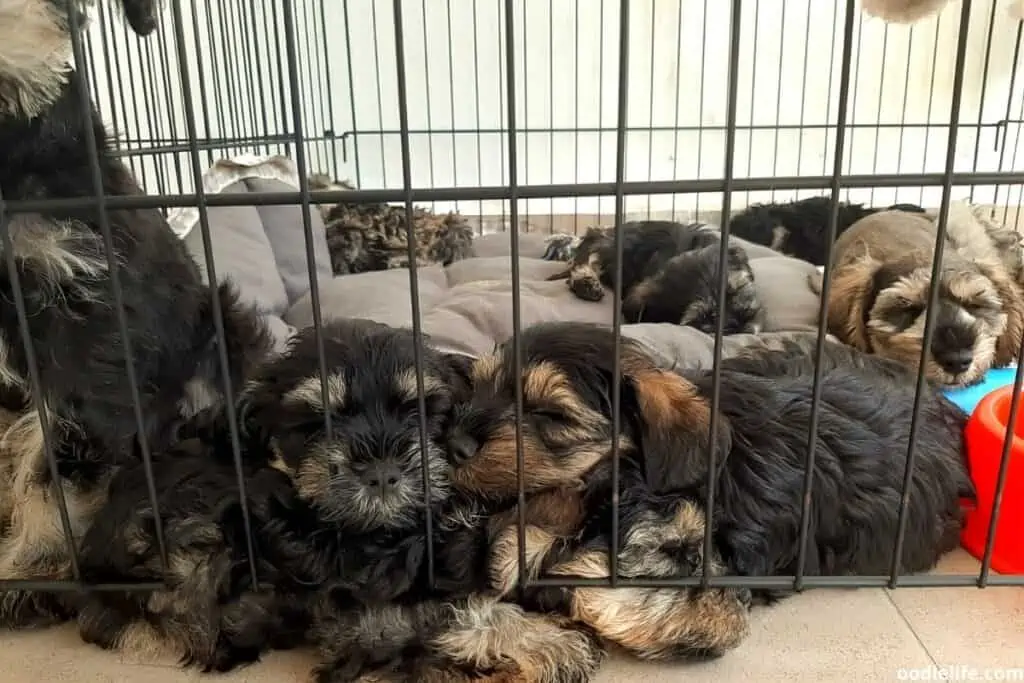Should You Cover a Dog Crate? Expert Tips and Insights
When it comes to crate training your canine companion, the debate about whether or not to cover a dog crate can be a contentious one. On one hand, covering the crate can create a den-like environment, providing your dog with a sense of security and comfort. On the other, it may cause some dogs to feel trapped or restricted.
As with most aspects of dog care, there isn’t a one-size-fits-all answer to this question. Instead, it’s essential to consider your dog’s needs and temperament in order to make the best decision for their well-being.

Some dogs naturally prefer having a cozy, enclosed space where they can retreat and feel safe, while others might feel more comfortable with a clear view of their surroundings. A crate cover provides the option to customize the crate environment for your dog’s specific needs. Before you decide to cover your dog’s crate, it’s crucial to understand the potential benefits, safety considerations, and various cover options available to ensure you’re doing what’s best for your furry friend.
Key Takeaways
- Covering a dog crate can provide a sense of security and comfort for some dogs while others may feel restricted
- Understand the benefits, safety considerations, and cover options before making a decision
- Customizing the crate environment for your dog’s needs and temperament is essential for their well-being.
Benefits of Covering a Dog Crate

Reducing Anxiety
Covering a dog crate can significantly help reduce anxiety in dogs. A covered crate creates a den-like environment, providing a sense of security for your furry friend. This is particularly useful for rescue dogs or dogs who have experienced trauma in the past.
They will feel more relaxed and safe in their own space away from any stressful triggers.
“One of my dogs would always shake like a leaf during thunderstorms. Ever since I started covering her crate, she remains much calmer during those loud moments!”
Creating a Comfortable Space
Dogs need a comfortable space to rest and sleep. By covering the crate, you help create a cozy and inviting environment that encourages relaxation. Adding blankets or padding inside the crate can further enhance the comfort level.
“My dog Buster loves his covered crate so much, he often retreats to it for afternoon naps! He knows it’s his little haven.”
Bedtime Routine
Integrating a covered crate into your dog’s bedtime routine can greatly improve their overall sleep quality. The cover not only blocks out ambient light but also assists in noise-canceling, allowing your dog to enter a deep, restful sleep.
“Ever since I started covering Bella’s crate at night, she falls asleep much faster and sleeps through the night without any disturbances.”
Minimizing Distractions
A covered crate can be a lifesaver for dogs who get easily distracted by their surroundings. By limiting their visual access to external stimuli, such as passing pedestrians or other pets, dogs can focus on resting instead of being on high alert.
“My pup Charlie would always bark at squirrels running around the yard. I decided to cover his crate and, voilà! No more squirrel-chasing sessions.”
In conclusion, covering a dog crate offers various benefits, from reducing anxiety to encouraging relaxation and sleep. Remember, a content and well-rested pup is a happy companion!
Safety Considerations When Covering a Crate
When it comes to covering your dog’s crate, there are a few safety considerations to keep in mind. It’s not all cozy blankets and peaceful naps; some real risks need to be addressed. This section dives into three essential sub-topics: Proper Airflow and Ventilation, Choking Hazards and Chewing, and Avoiding Overheating and Distress.

Proper Airflow and Ventilation
Just like humans, dogs need fresh air to breathe! It’s important to ensure that your dog’s covered crate still has ample airflow and ventilation. When selecting a cover, opt for something breathable, like a lightweight fabric or mesh material. Remember, a well-ventilated crate isn’t just for breathing purposes.
It also helps to keep unpleasant odors and humidity at bay. So, when picking out that cover, make sure your dog’s crate doesn’t end up as stuffy as an overpacked suitcase.
Choking Hazards and Chewing
You might be in for a “ruff” time if you don’t account for your dog’s chewing habits. Dogs, especially puppies, love to chew on things they’re not supposed to – including crate covers. When covering a crate, avoid using materials that might pose a choking hazard if ingested, such as plastic or strings.
To discourage chewing, consider spraying the cover with a deterrent, like bitter apple spray. And, because you can’t be too cautious, it’s a good idea to check the cover regularly for any signs of damage.
Avoiding Overheating and Distress
Imagine wearing a wool sweater during a heatwave. Sounds dreadful, right? That’s why it’s essential to avoid overheating your dog in their covered crate. Pay attention to the material of the cover, and switch to something lighter during warmer weather.
It’s also crucial that you keep an eye on your dog’s behavior. If they show signs of distress, such as excessive panting or restlessness, it might be time to remove the cover or consider alternative cooling options, like a fan.
And there you have it! But remember, as snug as a bug in a rug is great for humans, but with your dog’s crate, it’s all about creating a safe and comfortable space for them to relax.
Choosing the Right Crate Cover

Materials
When selecting a crate cover, consider the materials used to create it. Options range from durable heavy-duty fabrics to more lightweight, breathable materials. Some pet owners prefer a quilted, plush fabric for added comfort, while others lean towards easy-to-clean, water-resistant materials.
By analyzing your dog’s habits and environment, you can decide on the right crate cover for your furry friend.
Insulated vs Breathable
Insulated crate covers provide added warmth on chilly days, making them perfect for cold climates. This type of cover has a thicker material that helps retain heat inside the crate and offers extra comfort for the pet. However, if your dog tends to overheat or if you live in a warmer climate, you may want to opt for a breathable cover.
Breathable crate covers allow for proper airflow, which can prevent overheating and offer a more comfortable environment for your dog.
Travel and Car Ride-Friendly
If you’re constantly boarding planes or taking road trips with your dog, a travel-friendly crate cover is a must-have. These covers usually have added functions like handles, luggage straps, and pockets for storing pet essentials. Additionally, ensure the cover has secure closures and can easily be attached or removed during your journeys.
Easy-to-clean materials are also a big plus for this type of cover, as the chances of spills or accidents during travel are higher.
Remember, the right crate cover can make all the difference in your dog’s overall comfort and well-being, whether you’re keeping them warm in the winter, providing proper airflow during sweltering summers, or venturing out on the road. Happy crate cover shopping!
Covering Techniques and Alternatives

Using Blankets
Using a blanket is a popular way to cover a dog crate. It helps create a cozy and comfortable environment for your furry friend. Blankets are particularly useful during bedtime routines to signal that it’s time to sleep.
When using a blanket, ensure that you leave enough openings to maintain proper airflow and prevent the crate from getting too stuffy.
Examples of blankets to use:
- Knitted blankets: Soft, cozy, and can add a decorative touch to the crate.
- Lightweight blankets: Ideal for maintaining airflow while providing some coverage.
Partially vs Fully Covering
When covering a crate, you have two options: partially covering and fully covering.
Partially covering: This technique involves draping a blanket or cover over a section of the crate, leaving some areas open to ensure proper airflow. It’s suitable for dogs that need a balance of privacy and visibility.
Fully covering: Some dogs may prefer a completely dark and enclosed space to feel secure. In such cases, you can fully cover the crate, but ensure there’s adequate air circulation to avoid any potential health hazards.
Decorative and Functional Options
Apart from blankets, there are other options for covering a dog crate that serve both decorative and functional purposes:
- Wire crate covers: These are custom-made covers designed specifically for wire crates. They often have side panels and mesh windows to allow proper airflow and visibility.
- Plastic crate covers: Suitable for plastic crates, these covers provide an additional layer of insulation, ideal for colder climates or drafty areas.
When choosing a covering for your dog’s crate, consider factors like the crate size, your dog’s temperament, and your home decor preferences. A crate cover should not only provide comfort and security for your pet but also blend well with your living space. And remember, a little humor or a fun design never hurts when making your dog’s crate more inviting!
Special Cases for Covering Dog Crates
Puppies and Potty Training
Puppies are like furry babies, ready to learn and adapt to their environment. When it comes to potty training, dogs are natural den animals. They don’t like soiling their sleeping area and thus, covering their crate provides them with that den-like experience.

This can help establish the rules of potty training and make the process easier for both the puppy and pet parent. Plus, we all know how much puppies like to express their opinions on potty training in the middle of the night – a covered crate can help buffer those adorable yelps for attention.
Brachycephalic Breeds
Next up, we have the short-faced, adorable brachycephalic breeds, like Pugs and Bulldogs. These cuties are prone to breathing difficulties due to their unique facial structure. Covering their crate helps regulate the temperature around them and reduces the risk of overheating – we wouldn’t want our snub-nosed friends to become stuffy, would we?

Easily Excitable Dogs
Some dogs are simply born to be social butterflies, which also means they might be easily excitable. A covered crate can act like a calming sanctuary for these energetic fur balls. Providing them with their own “hush zone” helps them understand when it’s time to settle down and relax.

Plus, it keeps their excitement under control during big events, like family gatherings or the arrival of the mailman (who knew delivering letters could be so thrilling?).
Chewers and Dogs with Pica
Last but not least, we have the notorious chewers and dogs with pica. For these pups, a wire dog crate might look like an all-you-can-chew buffet. Covering the crate reduces their temptation to sample the crate delicacies and can help protect their teeth and your sanity.

When selecting the best way to cover a dog crate for chewers, opt for a material that’s durable and not easy for them to reach. You can also consider providing an appropriate chew toy as an alternative to satisfy that chewing urge.
And there you have it. A quick guide on special cases where covering a dog crate can benefit our canine companions. Though remember, each dog is unique, and it’s essential to observe how they respond to different crate setups to find what works best for their specific needs.
Good luck!
Frequently Asked Questions
Is covering a dog crate beneficial for reducing barking?
Covering a dog crate can indeed be helpful in reducing barking. It creates a den-like atmosphere, where the dog feels secure and protected. This often reduces the dog’s desire to bark, particularly in response to external stimuli that they perceive as a threat.
However, keep in mind that the effectiveness of this method may vary depending on the individual dog, their temperament, and the reasons behind their barking.
What are the effects of using a blanket to cover a dog crate?
Using a blanket to cover a dog crate can be effective in making your dog feel more relaxed and secure. A blanket not only creates a dark, quiet environment but also acts as a visual barrier, preventing your dog from becoming over-stimulated by external events.
While a blanket can be a cost-effective option, ensure that the blanket is breathable, easy to clean, and does not completely block air circulation.
Does a breathable crate cover provide better comfort?
Yes, a breathable crate cover can be a better option than using a blanket, particularly in terms of comfort, air circulation, and avoiding overheating. These covers are designed specifically for crate use, ensuring a secure fit and allowing better airflow while still providing the desired den-like atmosphere for your pooch.
Should you provide water in a dog crate during the day?
Providing water in a dog crate during the day is essential, especially when your dog is crated for longer periods. Make sure to use a spill-proof water bowl or a water bottle designed for crates to prevent accidents.
However, it is important to remove water from the crate if you have a young puppy who is still being crate trained to avoid creating a habit of eliminating in the crate.
How long should a dog sleep in a crate each night?
The amount of time a dog should sleep in a crate each night can vary depending on factors such as age, temperament, and their daily routine. Generally, an adult dog can sleep in a crate for 6-8 hours during the night without any issue.
Puppies, on the other hand, will need more frequent breaks due to their smaller bladders. Make sure to take your puppy out for a potty break before bedtime and adjust the crate duration accordingly.
What are some effective ways to reduce a puppy’s crying in the crate?
Reducing a puppy’s crying in the crate might take some patience and consistency. Some effective ways to help your puppy feel more comfortable include:
- Proper crate training: Introduce the crate gradually, making it a positive and welcoming space.
- Tiring them out: Make sure your puppy has enough physical and mental stimulation during the day.
- Providing comfort: Consider adding a soft toy or an item of clothing that carries your scent to make the crate feel more familiar.
Remember, time and consistency are key when it comes to helping your puppy adjust to their crate.